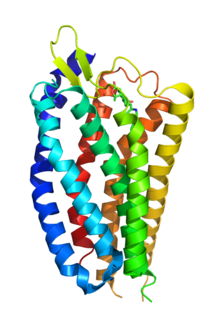Protease Activated Receptors
Protease-activated receptors (PARs) represent a subgroup of G-protein-coupled receptors . The activation of this type of receptor is based on the action of serine proteases (especially thrombin ) which cleave off the extracellular N-terminus of the receptor and thereby expose a protein domain that acts as bound ligand ( tethered ligand ) functions and remains permanently associated with the ligand binding domain of the receptor. PARs play an important role in platelet activation and in the context of various atherosclerotic processes.
Classification and occurrence
A distinction is made between four PAR isoforms (PAR1–4), of which PAR1, PAR3 and PAR4 can be activated by thrombin under physiological conditions. PAR2 is not activated by thrombin, but by various other coagulation factors such as trypsin . So far, protease-activated receptors have been discovered and characterized in various cell types of the vascular system (including thrombocytes, endothelial and smooth muscle cells). In addition, PARs could also be detected in cells of the nervous system and in T lymphocytes .
Biological function
The functional importance of the protease-activated receptors has so far mainly been investigated on vascular cells. The most important function of the PARs here is to mediate thrombin signals into the cell interior. Starting from the thrombin-activated receptor and the heterotrimeric G-proteins associated with it on the cytoplasmic side , intracellular signaling pathways are activated - different depending on the receptor isoform and cell type - and thus certain cellular processes such as cell activation (in platelets), proliferation , migration, cell matrix synthesis (in vascular smooth muscle cells) etc. controlled.
Individual evidence
- ↑ L Martorell, J Martínez-González, C Rodríguez, M Gentile, O Calvayrac, L. Badimon: Thrombin and protease-activated receptors (PARs) in atherothrombosis . In: Thromb Haemost . 2008 Feb; 99 (2): 305-315, PMID 18278179
- ^ SR Coughlin, E. Camerer: PARticipation in inflammation . In: J Clin Invest. 2003 Jan; 111 (1): 25-27, PMID 12511583
- ^ R Bar-Shavit, M Maoz, Y Yongjun, M Groysman, I Dekel, S Katzav: Signaling pathways induced by protease-activated receptors and integrins in T cells . In: Immunology. 2002 Jan; 105 (1): 35-46, PMID 11849313
